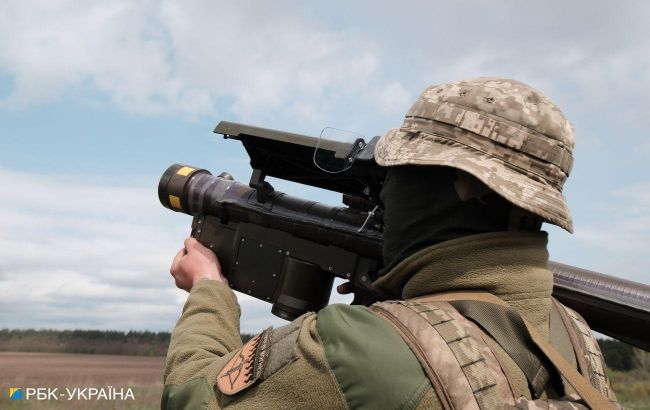Drone attacks on Ukraine: What’s behind extended hovering of UAVs
 Photo: Air defense system worked all night and morning due to Russian attack (Vitalii Nosach, RBC-Ukraine)
Photo: Air defense system worked all night and morning due to Russian attack (Vitalii Nosach, RBC-Ukraine)
Since last night, from 11 PM until this morning, a drone attack has been ongoing across Ukraine. Shaheds have been maneuvering chaotically from one region to another. Most regions have already lifted their danger alerts, and the Air Force has reported on the air defense results. However, one enemy target continues to circle in the sky.
Why the air alert lasted so long in some regions, what Russia's objectives might be and more details on the attack - in the RBC-Ukraine's material bellow.
Content
Details on attack
Throughout the night and morning, most regions of the country were under threat from enemy strike UAVs. This included Kyiv, towards which, according to preliminary information from KMVA, up to ten enemy drones were headed. These were destroyed on the outskirts of the capital. Kyiv later declared its fourth air alert related to the threat of ballistic missiles.
In some regions, monitoring groups have even recorded new records for the duration of alerts:
- 9 hours 39 minutes - the Kirovohrad region
- 9 hours 53 minutes - the Mykolaiv region
- 11 hours 52 minutes - the Dnipropetrovsk region (excluding some communities affected by artillery).
Initially, drones approached from the south and north, maneuvering through central regions, and by morning reached the west. Alerts were issued due to drones in the Rivne region, and air alerts were also heard in Volyn.
Later, the Air Force reported that Russia launched 72 aerial targets at Ukraine overnight: 69 Shaheds, two Iskander-M/KN-23 ballistic missiles, and one Kh-59/Kh-69 missile.
The air defense forces managed to shoot down the latter, as well as 50 suicide drones. Air defense was active in the Khmelnytskyi, Poltava, Cherkasy, Kyiv, Vinnytsia, Ivano-Frankivsk, Dnipropetrovsk, Mykolaiv, Odesa, Kherson, Donetsk, Kirovohrad, Sumy, and Chernihiv regions.
16 enemy drones were lost to location-based impacts, likely due to radio-electronic countermeasures. Another Shahed entered Belarusian territory and the Belgorod region of Russia.
As of 11:15 AM, one enemy drone was still in the airspace over Cherkasy, later moving towards Vinnytsia.
What prolonged hovering of drones means
It's difficult to say exactly what the enemy's specific intent was, but it is highly likely that such hovering is meant to provoke a response from our air defense, suggests military expert Pavlo Narozhnyy.
"Perhaps they are trying to activate radars or trigger some launch system, aiming for a powerful strike, such as a missile," he explains to RBC-Ukraine.
Another possible scenario, according to the expert, is that these Shaheds may be equipped with devices that collect information, which is then analyzed. In this context, the expert recalls instances where Shaheds entered Belarusian territory and fell there. Notably, one drone "disappeared" on Belarusian territory today.
"There is no confirmation of this version, but it is understood that it's a provocation. They have done this before and are doing it now," Narozhnyy emphasizes.
He also explained the specifics of shooting down suicide drones. He noted that in most cases, Shaheds are attempted to be shot down with small arms, such as large-caliber machine guns or anti-aircraft installations.
"But when such weapons are unavailable, medium and long-range air defense systems, like the Soviet Buk or Western Hawks, are used. However, missiles are in deficit, and if we use them on Shaheds, we won't be able to use them against cruise missiles. But drones are shot down for a long time, not entirely because of this," says Narozhnyy.
He reminded us that not all Ukrainian territory is covered by air defense systems. There are "covered" areas where important objects are located, and air defense protects them specifically.
"We cannot currently cover our entire area. That's why it's happening like this," Narozhnyy notes.
When asked if the Russians might be preparing for a massive combined attack on Ukraine's Independence Day, the expert does not rule out this scenario.
"They are very fond of significant dates. Recall the massive Shahed attack on New Year's. Why New Year's? Who knows what's on their minds... They also carried out a combined attack on May 8. They love such ('sacred' - ed.) dates. So, we need to be cautious and vigilant around Independence Day. Although it is also important not to ignore air alerts on other days," Narozhny concludes.
Sources: data from the press service of the Ukrainian Air Force, KMVA, monitoring channels, and an exclusive comment from military expert Pavlo Narozhnyy.

